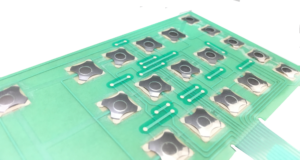Why Membrane Switches Are a Preferred Choice for Medical Devices
Why Membrane Layer Switches Over Are Essential for Durable Control Equipment
Membrane buttons play a critical duty in making sure the toughness and reliability of control systems throughout various sectors. As we explore the diverse advantages of membrane layer switches, it ends up being evident that their relevance transcends simple capability, influencing customer experience and operational effectiveness.
Introduction of Membrane Layer Switches
Membrane switches are flexible and trusted components frequently made use of in various electronic control systems. These buttons include several layers, including a visuals overlay, a spacer layer, and a published circuit layer. The visuals overlay gives both functional and aesthetic style, while the spacer layer makes sure that the buttons are turned on only when pressed. The printed circuit layer consists of conductive traces that finish an electric circuit when the membrane layer is pushed, making it possible for the device to respond to user inputs.
Membrane layer buttons are commonly preferred in applications needing a small and lightweight design, making them optimal for portable tools, medical devices, and industrial equipment. They can be customized to meet specific customer requirements and can include various features such as backlighting, tactile comments, and several colors. Additionally, membrane buttons are immune to dust, moisture, and contaminants, making them suitable for settings where durability is crucial.
Benefits of Toughness
In numerous applications, the resilience of membrane layer changes offers considerable advantages that boost their general efficiency and dependability. These switches are designed to hold up against extreme environments, making them excellent for use in requiring conditions such as high moisture, extreme temperature levels, and exposure to chemicals. Their robust construction helps to avoid damage from physical influence, guaranteeing lasting capability and reducing the requirement for frequent replacements.
In addition, membrane buttons are resistant to put on and tear, which is important in applications where constant interaction happens. This durability equates to decrease maintenance expenses, as companies take advantage of decreased downtime and fewer solution interruptions. Moreover, the encapsulated layout of membrane changes secures inner components from dust and wetness access, more contributing to their life-span.
An additional advantage is their ability to preserve regular efficiency with time. With a high resistance for mechanical anxiety, these buttons preserve their responsive responses and electric integrity, guaranteeing user complete satisfaction. Ultimately, the toughness of membrane layer switches not only boosts functional performance however additionally fosters self-confidence in their integrity, making them a recommended selection for control systems throughout different industries.
Applications in Different Industries
Resilient control systems employing membrane switches find comprehensive applications across a variety of sectors, each taking advantage of the special qualities these switches offer. In the clinical field, membrane layer switches are vital for gadgets such as patient displays and analysis devices, where reliability and convenience of cleaning are paramount. Their resistance to dampness and pollutants ensures they keep capability in sterilized environments.
The auto sector leverages membrane buttons for dashboard controls and infotainment systems, where they offer sleek, inconspicuous interfaces that boost individual experience. These switches are additionally created to endure rough conditions, consisting of exposure to severe temperature levels and vibrations.
In commercial settings, membrane layer switches are generally utilized in machinery control board, offering responsive comments and resilience essential for high-usage applications. Their capability to stand up to chemicals makes them suitable for making environments where spills and contaminants are constant.

Consumer electronic devices, such as cooking area appliances and push-button controls, additionally utilize membrane buttons for their versatility and cost-effectiveness. On the whole, the flexibility and durable nature of membrane switches make them vital throughout various industries, making sure reliable procedure and long life in control systems.
Design and Aesthetic Charm
While performance is extremely important, the design and aesthetic appeal of control systems geared up with membrane switches play a critical role in user engagement and overall experience (membrane switch). The visual design of these switches can substantially affect customer assumption and communication. A properly designed membrane layer button improves the appearance of the gadget, making it a lot more attractive to individuals and promoting a connection between the user and the product
Membrane switches over supply a large amount of adaptability in layout, enabling makers to personalize graphics, colors, and textures to straighten with brand name identity and product aesthetic appeals. Using dynamic colors and distinct patterns can attract interest, while tactile responses can enhance the this article individual's interaction with the device. In addition, the capability to integrate LED indicators and backlighting right into the membrane button style offers both functional and visual benefits, enhancing presence and functionality in various environments.

Enhancing User Experience

In addition, membrane switches can be customized to integrate graphical interfaces, improving functionality by offering details in a clear and instinctive fashion (membrane switch). This modification can consist of symbols, tags, and shade coding that overview customers via facility capabilities effortlessly. Additionally, their versatility enables integration in various environments, ensuring regular efficiency whether in commercial equipment or consumer electronics
The sturdiness of membrane buttons also plays an important function in customer experience. By holding up against severe problems and prolonged usage, these switches reduce the likelihood of system failings, hence promoting integrity and customer confidence. Ultimately, the strategic usage of membrane layer changes not only boosts performance but additionally dramatically enhances user communication with control systems, making them a vital element in modern layout.
Final Thought
